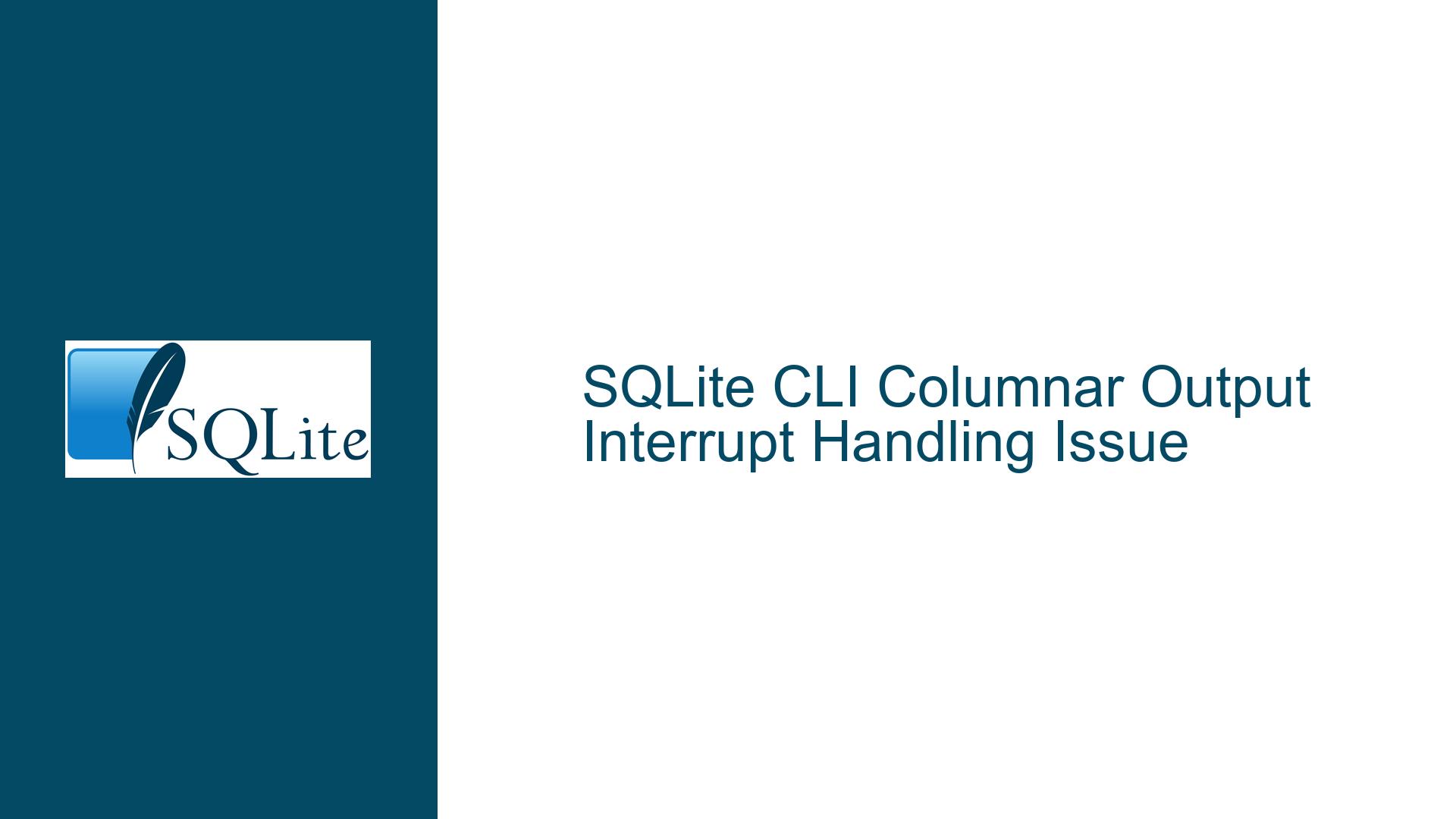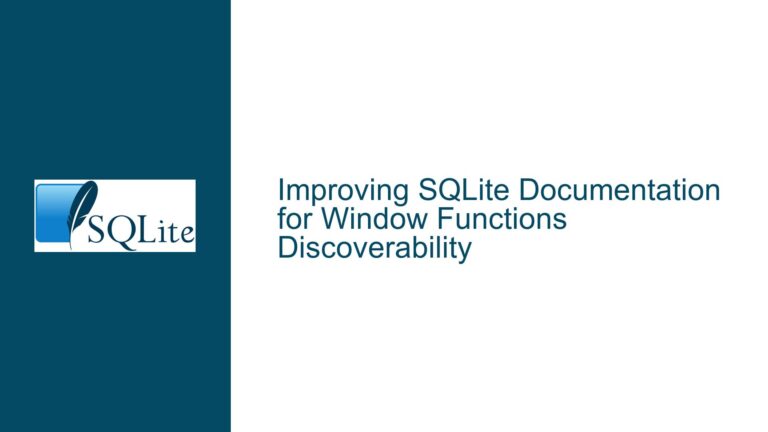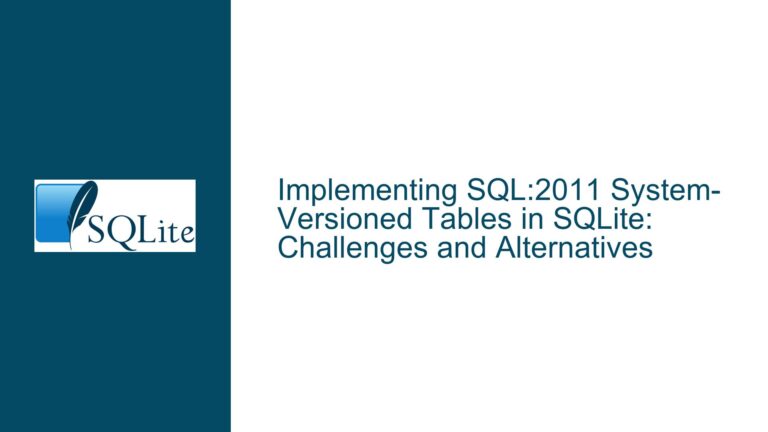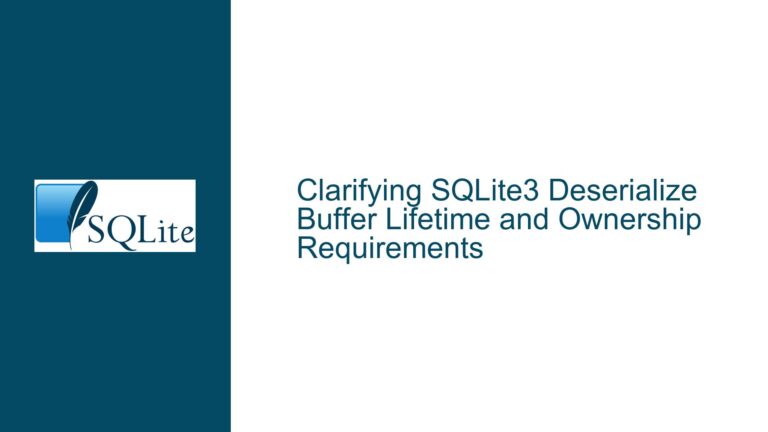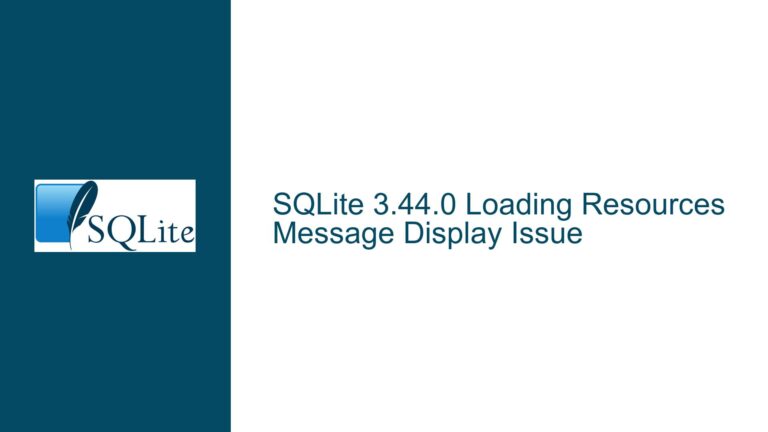SQLite CLI Columnar Output Interrupt Handling Issue
SQLite CLI Columnar Output Rendering Blocks SIGINT Interruption
When using the SQLite Command Line Interface (CLI) in columnar output modes such as .mode box, .mode column, or other similar formats, users may encounter a situation where the SIGINT signal (commonly triggered by pressing Ctrl+C) does not interrupt the rendering of query results as expected. This behavior is particularly noticeable when dealing with large datasets, such as a table containing one million rows. In non-columnar output modes like .mode list, the SIGINT signal successfully interrupts the query execution, allowing users to stop the output after seeing only a few rows. However, in columnar modes, the CLI must first complete the entire query execution and buffer the results before rendering the output. This design leads to a scenario where the SIGINT signal only interrupts the query execution phase, which is already complete by the time the output rendering begins. As a result, users cannot interrupt the rendering process, and the CLI continues to display the buffered results until completion.
The issue stems from the inherent design of columnar output modes, which require the entire result set to be available before formatting and displaying the data. This buffering mechanism ensures that the output is neatly aligned in columns, but it also introduces a delay between query execution and output rendering. During this delay, the SIGINT signal handler is unable to interrupt the rendering process because the signal is only processed during query execution. This behavior can be particularly frustrating for users working with large datasets, as they are forced to wait for the entire result set to be rendered, even if they only need a subset of the data.
Buffered Output Rendering Prevents SIGINT Signal Handling
The root cause of this issue lies in the way the SQLite CLI handles output rendering in columnar modes. When a query is executed, the CLI first fetches all the rows from the database and stores them in an internal buffer. Once the entire result set is buffered, the CLI begins formatting and rendering the output. This two-phase process (query execution followed by output rendering) creates a window during which the SIGINT signal cannot effectively interrupt the rendering process.
In non-columnar modes like .mode list, the CLI streams the query results directly to the console as they are fetched from the database. This streaming approach allows the SIGINT signal to interrupt the query execution and output rendering simultaneously, providing users with immediate feedback and control over the process. However, in columnar modes, the need to align data into columns requires the CLI to know the width of each column in advance. This necessitates buffering the entire result set before rendering, as the CLI must first determine the maximum width of each column based on the data.
The SIGINT signal handler in the SQLite CLI is designed to interrupt long-running operations, such as query execution. However, once the query execution is complete and the CLI transitions to the output rendering phase, the signal handler is no longer active. This design oversight means that users cannot interrupt the rendering process, even if they realize they no longer need the full output. The issue is exacerbated when dealing with large datasets, as the rendering phase can take a significant amount of time, leaving users unable to regain control of the CLI until the process completes.
Implementing Row-Based SIGINT Checks and Output Buffering Optimizations
To address this issue, the SQLite CLI can be modified to incorporate row-based SIGINT checks during the output rendering phase. By introducing periodic checks for the SIGINT signal after rendering each row, the CLI can provide users with the ability to interrupt the rendering process. This approach would allow the CLI to stop rendering and return control to the user, even when operating in columnar output modes. Additionally, the CLI could be optimized to reduce the amount of buffering required for columnar output, thereby minimizing the delay between query execution and output rendering.
One potential solution is to modify the SIGINT signal handler to remain active during the output rendering phase. This would involve extending the signal handler’s scope to cover both query execution and output rendering, ensuring that users can interrupt the process at any point. However, this approach requires careful implementation to avoid introducing race conditions or other unintended side effects. Another option is to implement a hybrid rendering approach, where the CLI streams partial results to the console while simultaneously buffering the remaining data for columnar alignment. This would allow users to see some output immediately while still benefiting from the neat formatting provided by columnar modes.
In addition to these technical solutions, users can adopt several best practices to mitigate the impact of this issue. For example, when working with large datasets, users can limit the number of rows returned by their queries using the LIMIT clause. This reduces the amount of data that needs to be buffered and rendered, making it less likely that users will need to interrupt the process. Users can also switch to non-columnar output modes when interactively exploring large datasets, as these modes provide more responsive SIGINT handling. Finally, users can leverage SQLite’s support for pagination and incremental rendering to break large result sets into smaller, more manageable chunks.
By combining these technical solutions and best practices, users can achieve a more responsive and controllable experience when working with the SQLite CLI in columnar output modes. The key is to balance the need for neatly formatted output with the ability to interrupt long-running operations, ensuring that users remain in control of their workflows at all times.
| Aspect | Non-Columnar Modes (e.g., .mode list) | Columnar Modes (e.g., .mode box) |
|---|---|---|
| Output Rendering | Streamed directly to console | Buffered and formatted before display |
| SIGINT Handling | Interrupts both query and rendering | Interrupts query only |
| User Control | Immediate feedback and interruption | Delayed feedback, no rendering interrupt |
| Best for Large Datasets | Yes (streaming allows interruption) | No (buffering delays interruption) |
| Best for Small Datasets | Yes | Yes (neat formatting) |
In conclusion, the issue of SIGINT interruption during columnar output rendering in the SQLite CLI highlights the trade-offs between output formatting and user control. By understanding the underlying causes and implementing targeted solutions, users and developers can work together to create a more responsive and user-friendly experience. Whether through technical modifications to the CLI or the adoption of best practices, the goal is to ensure that users remain in control of their workflows, even when working with large and complex datasets.
